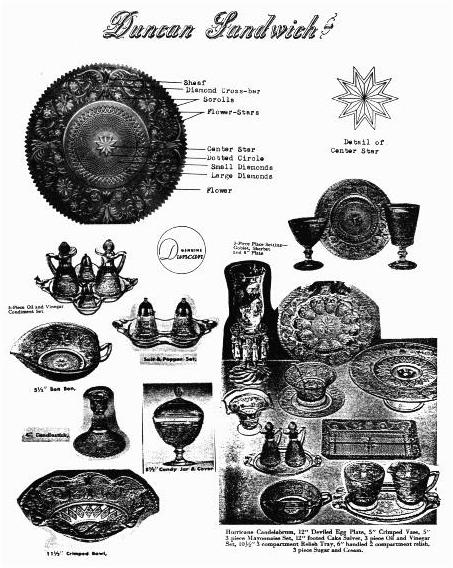National Depression Glass Association
Preserving America's Glass Manufacturing Heritage
Duncan & Miller's "Sandwich" Pattern
by Virginia Scott
Rainbow Review Glass Journal - December 1975
The "Sandwich" patterns are very popular with glass collectors.
Since these patterns were made by several companies, there is a great
 deal of confusion as to how to tell the difference in them. I have
found ads and pictures of Sandwich productions of Duncan, Westmoreland,
Anchor Hocking, Indiana and others and will, in my next several
articles, attempt to point out some of the ways that they are alike and
how they differ.
deal of confusion as to how to tell the difference in them. I have
found ads and pictures of Sandwich productions of Duncan, Westmoreland,
Anchor Hocking, Indiana and others and will, in my next several
articles, attempt to point out some of the ways that they are alike and
how they differ.
Duncan & Miller Glass Company brought out their "Early American Lace Glass" in 1925. They later adopted the name "Duncan Sandwich." "Deming Jarves made pieces like these in the Cape Cod village of Sandwich," one Duncan ad declared. "To make the Duncan molds, his star-and-scroll design, probably the best of Early American designs, was carved by hand in solid steel, just as it was at Sandwich." Another ad stated, "Your great grandmother may have had something exactly like this. She probably called it 'lace glass' or 'star and scroll'."
The "star and scroll" description for Duncan Sandwich is a good one to keep in mind. The pattern is formed of fancy winged scrolls which surround a sheaf. (see illustration, top left) The sheaf is made up of three sections which have points at each end and it is bound or tied in the center with a diamond shaped crossbar. This diamond is the best way to distinguish the Duncan Sandwich pattern as it was used only by Duncan. Another Duncan characteristic is the six-pointed flower-star or rosette which appears within the curved part of each scroll. The background of the pattern is formed of very small dots which are quite close toçether. On some pieces a flower with 12 petals alternates with the sheaf and scroll motif. Most Duncan items have a star with 10 sharp points in the bottom. This star is usually set in a circle of very small dots. That circle is surrounded by an area of small diamonds which, in turn, is usually surrounded by one or more rows of larger diamonds which have a pattern of dots end crosses. This last pattern may vary somewhat from piece to piece, depending on the shape. Duncan Sandwich is clear and brilliant and the design is sharp and well-defined where touched.
Duncan Sandwich was made in an extensive line of pieces and shapes. A Complete line of table-setting pieces was made including many sizes of plates, stemware, flat and footed tumblers, seafood server, oyster cocktail and several sizes of dessert dishes. Many special serving dishes and accessory pieces were available. Some of the most attractive pieces were the condiment sets on trays. In the 1920s Duncan made their Sandwich pattern in crystal, green, amber and rose. Ruby was advertised in the early 1930's and chartreuse in 1949.
After Duncan & Miller closed in 1955, the Sandwich pattern was continued at U.S. Glass Company in their Duncan & Miller Division. In the 1960s, Indiana Glass Company acquired the Duncan moulds. A few molds have been used for some pieces of Indiana's Tiara Sandwich glass. The pattern has also been manufactured by Indiana, for Lancaster Colony. In 1972 Lancaster Colony used 19 Duncan moulds to manufacture colored Sandwich glass for the Montgomery Ward "Century 2" celebration, which commemorated their 100 years in business.